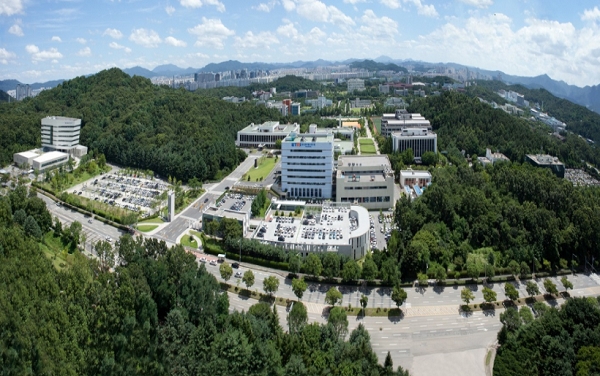Seoul (2018/12/04)- Have you ridden KTX high-speed train from Seoul to Gangreung City, a host city of PyeongChang Winter Olympics to watch a 500 meter women’s speed skating race held it Gangreung Ice Skating Stadium during the Olympic Games period? Once you have gotten on board, you might be excited to have your smart phone log onto an in-train Wi-Fi network and then download and watch 1 gigabit of video data every second seamlessly on the fast-moving high-speed train.
The high speed in-train video downstream was enabled by the test-run service of Korea’s home grown mobile ultra-high speed Internet access Giga Wi-Fi service during the Olympics Games period.
Developed by state-funded ETRI, or Electronics and Telecommunications Research Institute, the Giga Wi-Fi technology is a sort of a next generation of ultra-high speed mobile Internet access communication technology that allows users to get on the Internet at a high speed of 1Gbps even on the fast-riding cars, buses and trains.

Codenamed as MHN, or mobile hotspot network, the technology was jointly developed by state-funded ETRI, or Electronics and Telecommunications Research Institute, SK Telecom, Seoul Metro Corp., Clever Logic, and KMW.
Seoul Metro is scheduled to commercially deploy the MHN services across Seoul subway stations sometime in 2019 using an unlicensed millimeter wave band to enable subway passengers to seamlessly watch video clips and log onto Webs at a lightning speed for nothing.
The joint-development and commercialization project of MHN is a crystal ball of how crucial technology incubator role ETRI has been playing in paving the way for Korea’s small and medium -size venture start-ups to tap into yet uncharted market and create a new business model.
“ETRI should support small-and medium-sized enterprises. Especially, we are considering to carve some specific applications for them. Small cells like femto and pico cells as well as repeaters and RU(radio units) are where we are focusing, because that’s where their forte comes in. When it comes to 5G femto cells, we license related software protocols to them and then they integrate it with baseband processor chips from Qualcomm or Broadcom to make small cells, “ said Hwang Seung Ku, senior vice president, Hyper-Connected Communication Research Center with ETRI
“The MHN is another example of how we have been working together with small and medium-sized venture start-ups to open up new market opportunities. The MHN technology is targeting public services, because it uses unlicensed bands for free. The millimeter wave band is not optimal for 5G communications, but the millimeter wave band as a wideband is a strong candidate for specific applications in military and industry environments,” added he

Unlike macro-cell-based mobile communications, according to him, this MHN is based on small cell system, where small and medium enterprises prevail.
It uses beam-forming multiple antenna system, covering a distance of between 200 meters and 2km. Seoul Metro will soon start deploying terminals and other equipment across a fleet of train cars and RU or radio units into subway railroads in tunnels for the 2019 commercial rollout.
Korean venture startup fabless chipmaker Clever Logic is designing and fabricating a baseband chip, while KMW is making RF equipment and devices.
has submitted the Giga-wifi, or MHN technology as a new Wi-Fi standard to the 3GPP group of IEEE.
Ultra dense network, or UDN is another small, or micro-cell mobile communications technology that ETRI is working on to commercialize.
Highly optimized to serve public places like sports stadiums, the UDN technology is a sort of usage case-specific technology that aims to enable users to seamlessly watch live streaming broadcasting of on-the-spot sports games on very population-dense and crowded areas like stadiums while watching the games on the scenes simultaneously.
“The UDN technology is to make up for shortcomings of today’s 4G and 5G mobile communications technologies, focusing on a technology algorithm to cancel signal interferences among base band, or modem chips. Using today’s mobile communications networks, service operators are embedding as many communications nodes as possible in one cell, or mobile station to increase capacity. The challenge is how to reduce or cancel signal interferences among nodes, “ said vice-president Hwang
Yet, UDN is a technology that can guarantees high capacity for communications, but minimizes or cancels signal interference or noises even in a very node-dense-areas. That signal interference cancellation translates into low cost deployment.
“In 4G and 5G mobile communications, traffic variations are very high depending on time and area. So, service providers have to support peak data rate wherever and whenever. But it costs dearly, but this UDN is not the case, coming cheaper, ” he stressed.
Once developed, ETRI will also license the technology to Korean venture start-ups to make it commercially available.
True enough, ETRI has been playing an active role in the commercial rollout of very sophisticated and high-end communications technologies. As IoT services are catching on across a broad range of industries from hospital to factories to logistics, ETRI’s technology incubating role allows small-and medium-sized venture start-ups to get easier and cheaper access to crucial, key building blocks technologies to create new business models and market
Credited by itersnews.com

